What, Exactly, Is A Kölsch Beer?
Summer is just around the corner and with spring already blossoming at our feet, there's no better time of year to enjoy a cold one. Trade in those mulled wines and hot ciders for an ice-cold beer and get into the spirit of warmer weather and longer days. However, the key to selecting the best beer for any occasion, spring parties or otherwise, relies on your knowledge of the stuff. But unless you're a beer expert (formally called a cicerone), you might not know the minute details of each and every beer on the market.
Whether you like a beer that's light and fruity or thick and creamy, there always seem to be dozens of varieties to pick from. You might be familiar with some basics — an IPA is bitter and hoppy while stouts and porters are dark and heavy. Occasionally, however, we run into brews that leave us stumped, like Kölsch. For an American, the word Kölsch alone has the potential to sound unfamiliar, which makes exploring the complexities of the beer itself a bit intimidating. However, if you enjoy cool, refreshing beverages made for long summer days, Kölsch might just be the drink for you. This unique light beer combines two common brewing approaches (one used for ales and another common in lagers) to create a well-balanced flavor profile with a light ABV.
Kölsch beer makes for easy drinking
The origin of Kölsch beers can be traced back to Cologne, Germany in the year 1396. Not only has this ancient German beer endured hundreds of years of human civilization, but its brewing process is equally as unique and complex.
Most beers exist under two categories — ale or lager. Which class a beer belongs to depends on temperature and the yeast that is used during the fermentation process. Ales, for example, employ "top-fermenting" yeast at high temperatures during the brewing process. This means the yeast used during production rises to the top as it brews. Lagers, however, are brewed at lower temperatures with "bottom-fermenting" yeast that settles to the bottom of the batch during production.
What makes Kölsch so unique is that the beer borrows from both brewing techniques by using top-fermenting yeast at low temperatures — the best of both worlds. Kölsch beers have a relatively low alcohol content and are traditionally served in a stange, a skinny, cylindrical glass that differs from the ever-common pint glass. Kölsch also boasts a crisp, refreshing flavor profile accented by subtle fruit aromas — beach day, anyone? So, next time you need a cold one for easy drinking, ask your bartender what Kölsch beers they have on tap.

